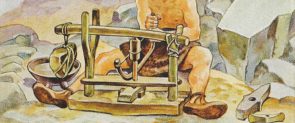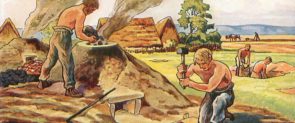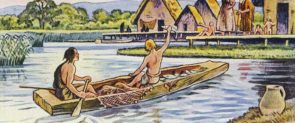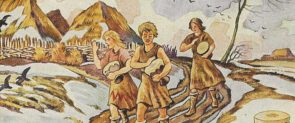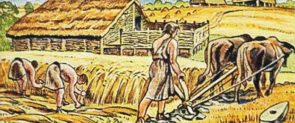This post is a continuation of a draft on palaeolinguistics and the Proto-Uralic homeland. Or, rather, a preliminary approach to the most likely key to understand the ultimate origin of Proto-Uralic.
Despite the multiple far-fetched proposals of long-range connections between Asian languages and Uralic – e.g. Ural-Altaic, Uralo-Siberian, Eskimo-Uralic, or Uralo-Dravidian – its closest language family is evidently Indo-European, whether by inheritance or by long-lasting intertwined language developments. This supports that Pre-Proto-Uralic and Proto-Uralic developed in Eastern Europe, always close to the Proto-Indo-European homeland. Therefore, it can be assumed that they were subject to similar external influences, as supported by their related European Agricultural Substrate.
Since many language contacts are usually not long enough to offer but a few potential parallels that are by definition irregular, the field of contact-induced language change is particularly prone to an excessive relaxation of the usual standards for regular phonemic and semantic parallels. To avoid this, the text below offers (first) an appropriate cultural and genetic setting for contacts between Proto-Uralic and Common West Caucasian, and (second) the most attractive potential phonetic and semantic connections, exclusively selected from items already classified as potential borrowings in Uralic due to their internal irregular correspondences and cultural context.
16.1. Common West Caucasian
The West Caucasian or Abkhazo-Adyghean language family consists of five languages grouped in three branches: Circassian (Adighe and Kabardian), Abkhaz-Abaza (Abaza and Abkhaz) and the extinct Ubykh. Historically, the West Caucasian tribes were probably first mentioned by the Greeks with their autonym Kerkhétai (5th c. BC). Besides Proto-Circassian, Proto-Abkhaz, and Proto-Ubykh, sister languages included probably Hattic and possibly Kaskian. The position of the last two is impossible to ascertain, as is the precise ancestral position of Ubykh between Circassian and Abkhaz (Chirikba 1996).
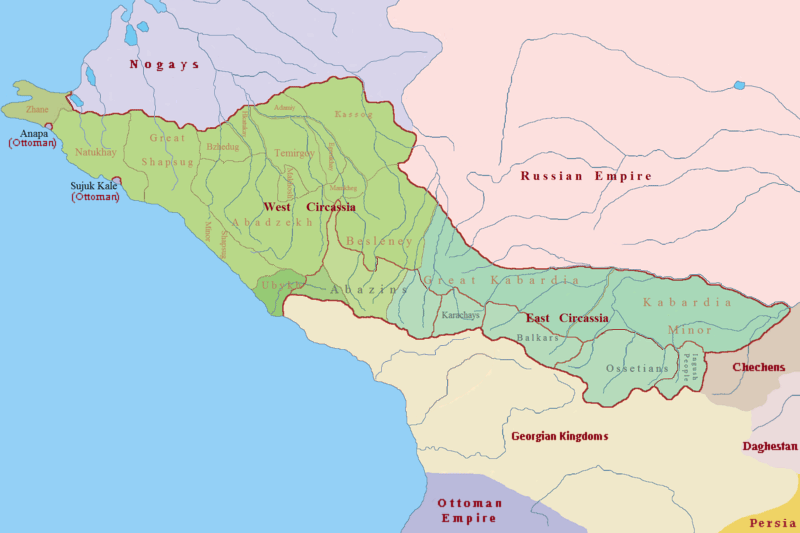
Lexical correspondences with East Caucasian or Nakh-Daghestanian (which also includes Hurro-Urartian) in all sections of its basic vocabulary shows a likely ancestral genetic relationship between North Caucasian languages (Nikolayev & Starostin 1994; Chirikba 1996), or at least a long-lasting Sprachbund and mutual contact-induced interference, whereas Kartvelian shows differences on all levels. These modern and ancient connections of both North Caucasian branches in combination with archaeology suggest that the first splits occurred around the Caucasus no later than the Eneolithic.
The split of Hattic (and Kaskian) from Common West Caucasian could be associated with a cultural spread around the Caucasus dating to the Neolithic, ultimately related to the Maykop culture. This expansion would be earlier than that of end-4th millennium BC Kura-Araxes culture, a likely vector of Hurro-Urartian in the region. Both Maykop and Kura-Araxes seem to be ultimately connected to the Darkveti-Meshoko culture (cf. Anthony 2019), hence a candidate to an ancestral North Caucasian-speaking community.
Caucasian splits dating to the Eneolithic are further supported by the language contact-induced change of Proto-Indo-European compared to Proto-Uralic, suggestive of a Caucasian morphophonological substratum – i.e. when both are considered as derived from an Indo-Uralic phylum (cf. Kortlandt 2002). Further, a likely lexical interference in Proto-Indo-European attributable to West Caucasian is formed by more than 200 lexical parallels proposed to date (e.g. Björn 2017, Bomhard 2019a, 2019b, 2020), although these still lack a consistent, systematic approach to regular correspondences and direction of borrowing.
NOTE. For clarity purposes, I will use Proto-West Caucasian (PWC) below to refer to cognates including Hattic, and Common West Caucasian (CWC) to refer to the proto-language reconstructible from modern languages.

A connection of Hattic and Kaskian to the Minoan language from Crete in a Hatto-Minoan group (cf. Schrijver 2015, 2019*) might be supported in archaeology by the spread of the Kastri/Lefkandi ceramic assemblage (ca. 2600-2300 BC) and the associated influence from Western Anatolia in terms of social complexity, monumental architecture, large storage facilities, fortifications, metallurgy and administrative use of seals (first employed in the Near East), accompanied by the appearance of western Anatolian derived ceramics (i.e. introduction of new eating and drinking habits).
* The few proposed lexical connections to Sumerian are probably better explained as Neolithic Wanderwörter.
In population genomics, this influx could be associated with the recent EBA expansion of a CHG-like population from Anatolia into the Aegean (cf. Lazaridis et al. 2017, Clemente et al. 2021). On the other hand, the Aegean Pre-Greek substrate seems to be formed in great part by the Anatolian branch of Proto-Indo-European, and the ancestry link of Minoans with Hattians and the Kura-Araxes population is unlikely to be very different from the Anatolian-speaking community due to the high demographic density of the region and gross ancestry homogenization dated millennia earlier.
Hints from future papers on Yamnaya and Corded Ware show that there is a direct connection between the R1a-rich Pre-Corded Ware population of Late Trypillia with Maykop (and further with Kura-Araxes) through the Steppe Maykop group, in terms of IBD sharing and probably also through its Khvalynsk-derived Y-DNA hg. R1b-V1636. This direct genetic connection was probably mediated by the expansion of the Maykop-derived Zhyvotylivka–Vovchans’k group throughout the North Pontic area, and is the most evident link of the Pre-Corded Ware community with their “Steppe ancestry” similar to the Yamnaya (see here my 2019 predictions).
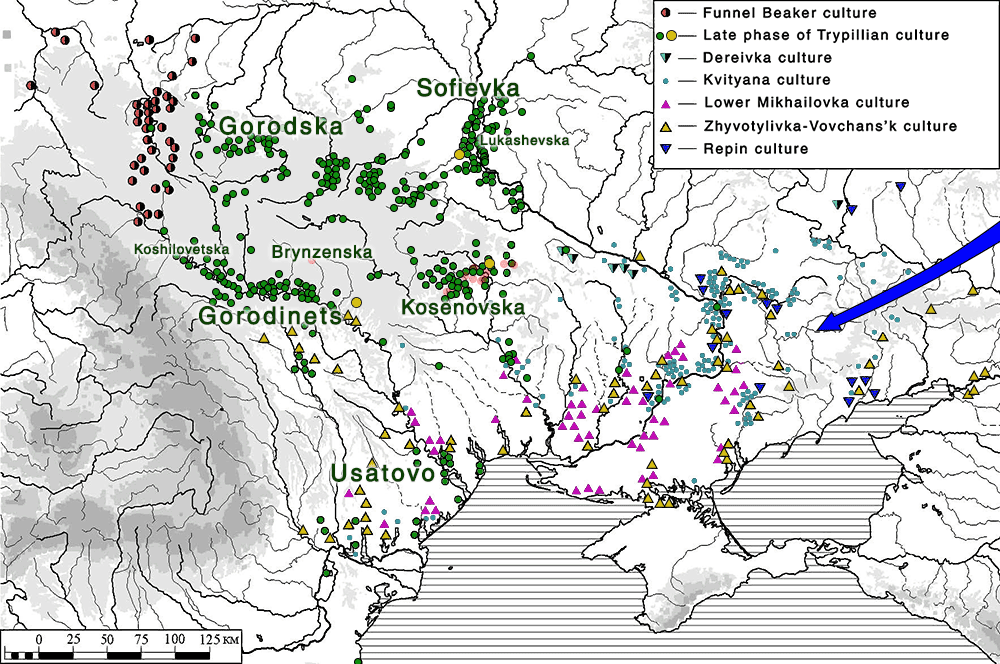
16.2. Lexical correspondences
To date, only a few Uralic-Caucasian lexical correspondences have been proposed, likely stemming from different stages and mediating languages. I will focus here on ancient contacts, avoiding more recent loans found in Hungarian, Mari, or Permic. The different palaeolinguistic reconstruction of PU and CWC cultures and the lack of discernible mutual substratal traits suggests that their contact was short-lived, more proper of a Caucasian adstrate/superstrate on Uralic.
The main problem with potential cognates is that too few of them are reliable enough to obtain regular phonemic correspondences. In fact, many reconstructed CWC lexemes involve monosyllabic stems, with a great part of these inferred from dialectally restricted disyllabic compounds, which leaves external (and even many internal) Caucasian comparanda as a speculative exercise. This is an evident minefield in language contact, whose irregular correspondences are particularly prone to excesses.
The main relevance of these likely or possible loanwords is that they are witness of direct CWC→PU, CWC→PU→(Pre-)PIIr., or CWC→(Pre-)PIIr.→PU contacts, all of which offer yet another hint to understand the actual location of the (Pre-)Proto-Uralic community before and during its contacts with Pre-PIIr. and PIIr., and before its dispersal in North-Eastern Europe and east of the Urals during the 3rd and early 2nd millennium BC.
The more widespread distribution of some CWC borrowings among Early Uralic dialects relative those belonging to the Agricultural Substrate might point to preceding contacts within an earlier Proto-Uralic period in the north Pontic region. However, the “Finno-Ugric” and “Finno-Permic” distribution of many examples suggests that both contact layers were roughly coeval, and that differences are most likely due to their radically different cultural context, given the known archaeological developments of Corded Ware-related groups: the Caucasian-related Pontic metallurgical tradition (and indeed trade and technology) continued to be an important part of Abashevo-related cultures beyond the Urals, whereas north-west Pontic agricultural techniques were not.

These are some seemingly straightforward (or otherwise reasonable) phonemic replacements found in potential cognates listed below, with the caveat that searching for regular vocalic changes is further complicated by the frequent lack of a proper reconstruction of the true nature of open vowels:
- CWC *ʕʷ → PU *w
- CWC *ɬ → PU *š
- CWC *CaCa → PU *CoCa
- CWC *ᴀ_tɬʷᴀ → PU *ɪ_(k)š(t)ɪ.
- Labialized, palatalized, labialized-palatalized and emphatic consonants may have influenced the vocalic output.
NOTE. This is the most tentative proposal based on a few parallels (1) because of the unlikely phonemic change into this labile cluster, and (2) because most examples of these un-Uralic combinations belong to words attributed to the Agricultural Substrate proper, supporting that they all belong to the language of Trypillians. Loanwords displaying this cluster would show loss of word-initial *k in all cases, whereas internally its loss is variable. The loss of *t is even more variable.
The simpler color code shows stronger background for more reliable cognates, and lighter background for less reliable ones. Underlined is the CWC form, with double line representing a PWC form. Background color also shows the proposed ultimate origin of a PU ~ PIIr. cognate in either PU → PIIr. or PIIr. → PU.
The discussion of each PU etymon can be found in the respective section of the Proto-Uralic Homeland series.
Metallurgy
CWC loanwords from Mythology & Metallurgy are the most common:
PU *wäśkä ‘copper; ore, brass’ ← **wäśä ← CWC *ʕʷə-ć̣ʷa ‘(lit.) black metal; iron’ (cf. Ub. wə-śʷa ‘copper’) from *ʕʷə ‘metal’ (Viitso 2012: 196). Compare also *ʕʷə-ɬʷa ‘(lit.) white metal; white copper’, *ʕʷə-pɬa ‘(lit.) red metal; red copper’ (Chirikba 1996: 400). Since ironwork was not generalized until well after the West Caucasian disintegration, it is very likely that the three reconstructible terms referred originally to different types of copper. The disharmonic shape PSmy. *wäsa ‘iron; metal; money’ (compared to the expected regular PU *wäśkä → PSmy. **wäsä) might arguably point to the original *ə-a alternation, which could tentatively be traced back to a Disintegrating Proto-Uralic stage. CWC *ʕʷa/ə is probably ultimately derived from the adjective *ʕʷa ‘yellow’, as found in Ub. ʁʷa (Chirikba 1996: 294).
PWU *šija-/*šijo-/*šiwa- ‘to grind, whet’ ← CWC *ɬʲə(-*ɬʲə) ‘to whet, grind, sharpen’; cf. CCirc. *ɬə ‘to whet, sharpen’, CAbx. (redupl.) *šʲə-šʲə ‘to grind, knead’ (Chiribka 1996: 274), with second component likely verbal suffixes.
PFP *šVra ‘grindstone; to grind’ (UEW Nº 1611; Aikio 2015:45), probably from the same stem CWC *ɬʲə(-*ɬʲə); the meaning of the second component is unclear, but it appears frequently in known compounds (see below). Compare for example *-ra/ə- ‘through’ (Chirikba 1996: 308).
PWU *waćara ‘axe?; hammer’ ← PIIr. *wáʒ́ras ‘club, mace’ ←? **ʕʷa + ǯʲə + rə, from CWC *ʕʷa/ə, cf. CCirc. *wa ‘to beat, hit, strike’, CAbx. ħ̥ʷə- ‘to beat up, whip’ (Chiribka 1996: 294). Derivatives include CCirc. *wə-rə ‘big hammer, sledge-hammer’ (Chiribka 1996: 426); and CCirc. *wə-ma ‘wooden club for hammering’, with instrumental suffix CWC *-ma (Chirikba 1996: 304). A PWC stem can be reconstructed in *-ra/ə from Hattic ureš ‘smith’ (Kammenhuber 462); compare also Hattic wae ‘working tools’ (Kammenhuber 494), and Ad. wată ‘hammer’ (Chiribka 2004: 426). The central component is probably an ancient intensifier, which would make sense for an ultimate mythological origin, as the Stormgod’s weapon wrought by the Divine Smith, due to the shared PIE~PWC myths; compare CCirc. -ǯʲə suffix adding up to the comparative degree of adjectives the meaning of the domination of the quality, e.g. Kab. năχ bədă-ž ‘even stronger’, Ub. za-ǯʲə ‘unique’ (za ‘one’), a-za-ǯʲə-χʷaraj ‘completely round’ (χʷaraj ’round’), CAbx. *-ǯʲə suffix intensifying the meaning of the word, e.g. Bz. a-χʷdə-ǯʲ ‘with thick neck’ (a-χʷda ‘neck’), a-kdə-ǯʲ ‘very heavy’ (a-kdə ‘log’) (Chirikba 237, 367).
PWU *šamara/*šimara/*šowV ‘butt’ ←? CWC *žʲə- ‘metal’, cf. CCirc. *ja-žʲə ‘ashes’, as CAbx. *žʲə-jə ‘smith’, into *žʲə-jə-ra ‘smithy’ (Chilibta 1996: 311; 400), *žʲ-aħʷa ‘hammer’, from *aħʷa ‘sword’ ← ‘striking weapon’ (Chiribka 1996: 262), or *žʲə-q̇ʲə ‘slag, dross’ (when producing metal), from *q̇ʲə ‘faeces’. For CWC *ma, cf. CCirc. *-ma instrumental suffix, Ub -m̲a ‘id’, CAbx. *a-m-ħ̥ʷa ‘handle’, *ma ‘hand’, *ma ‘to have’ ← ‘to have in hand’ (Chirikba 1996: 304). Compare, for compounds, Circassian *wa-ma ‘wooden club for hammering’ (see above), *q̇a-ma=psǝ-ma ‘tool’ (*q̇a ‘hand’, *psa ‘to plane, shave’), and for Ubykh ḳʲa-m̲a ‘hammer’ (cf. ḳʲa ‘to forge’), gʲašʷa-m̲a ‘tool for cutting, chopping, digging, etc.’ with gʲašʷa ‘hammer’.
NOTE. CAbx. *aħʷa ← *(a)sʷa, cf. CCirc. *sa ‘sabre; knife’, CAbx. *aśa ‘sword’, Ub. ašʷa ‘scythe, sickle’. While vocalic anlaut is supported by Ubykh (Chiribka 1996: 317), Nikolayev & Starostin (1994) consider this an Abx. loan, and reconstruct CCirc. *s ~ CAbx *ś as from PWC *ś.
PFP *pišti/*pikši ‘pliers, splint holder’ ← CWC *ṗtɬʲa-, cf. CCirc. *ʁa-ṗɬʲa ‘to (com)press, iron’ (*ʁa- causative prefix), CAbx. *pšʲa ‘to become soft, soften (of cow’s udder)’ (Chirikba 1996: 271). Semantically, it would make sense as a loan from a set of vocabulary specialized in metalworking, even though the original context in West Caucasian is unclear.
PFP *wala-/*wälä- ‘to pour; to cast (metal)’ ←? CWC *ʁʷa-dɮa, cf. CCirc. *ʁʷa-tħa, Ub. ʁʷa-Ła ‘to urinate’, from *ʁʷa ‘to pour (as liquid)’, cf. CCirc. *ʁʷa-, Ub. ʁʷa, SAbx. -ʁʷa (Chirikba 1996: 269; 284). The second component could be instead from verbal suffix *-la cf. CCirc. *-La/ə habitual/excessive suffix, CAbx. *-la durative suffix (Chirikba 1996: 306-307).
PFP *taško/*tašV/*tuškV ‘grindstone; back of a knife or an axe’ ←? CWC *ṭǝ-, found in compounds Kab ṭǝgʷǝ ‘butt, back (as of axe)’, Abx. (Abzh.) a-ṭǝq’ʷ (Chirikba 1996: 190). For the second component, compare maybe CWC *(š)ḳʷa/ǝ (Chirikba 1996: 143, 351) or *č(’ʲ)ḳʷa (Chirikba 1996: 205), both meaning ‘press, squeeze, crush’.
PWU *raško ‘forked thing, splint holder’ ←? **rǝ + (š)ḳʷa/ǝ, from CWC *(š)ḳʷa/ǝ (Chirikba 1996: 143, 351), cf. CCirc. *pa-šḳʷǝ/a ‘to pinch’, Ub. ḳʷaḳʷǝ ‘to pluck (as chicken); to card (as wool); to pull out’ (Charachidzé, Esenç 1992-1993: 20-21), CAbx. *ḳʷǝ-ḳʷǝ ‘to scutch, swingle, comb, card (wool); to tear to pieces’ (Chiribka 1996: 205, 351). For the first component, cf. CWC *rǝ- causative prefix in Ub. dǝ-, CAbx. *rǝ-.
Technology and Trade
Loanwords from Technology & Trade are also frequent:
PU *kota ‘hut’ ← CWC *kata cf. CCirc. *kʰatʰə ‘sheep-shed’, CAbx. *kəta ‘village’. Chirikba (1996: 199), who reconstructs a meaning ‘settlement with sheds for cattle (?)’, also notes the existence of similar word in other languages suggesting a “cultural migrational term”. Its regular reconstruction for CWC supports it – in common with Proto-Uralic – as the oldest attestation of the term, dating to the 4th-3rd millennium BC. Since there is no clear single origin for all dialectal cognates of this Eurasian Wanderwort in Indo-European dialects, the division between reconstructed *o-a and *a-a stems could point to an ancestral Uralic vs. Indo-European loanword ultimately adopted from CWC.
PFU *wosa ‘product, trade’ ← CWC *wasa ‘sheep; price’, cf. CCirc. *wása ‘price’ vs. CAbx. *wasá ‘sheep’ (Chirikba 1996: 361). While it could be considered a secondary semantic development in Circassian, or even independent stems, it seems reasonable to assume a common ancestral stem and meaning evolution akin to the one assumed for PIE *peku ‘livestock’ → ‘property’. Dubious mainly because of the good alternative fit for a Proto-Indo-Anatolian borrowing.
NOTE. In light of the potential independent stems, the question is whether Indo-Anatolian *wos-n̥ ‘sale’ or Indo-Anatolian/Indo-Tocharian *wos-e-i- is related to CWC and/or PU, or to both simultaneously through a PIE → CWC → PU, or even as a PIE → PU → CWC, since vocalic and consonantal correspondence can be assumed to be the same in this case in a PU → CWC loan. Bomhard (2019a: 19) considers exclusively CAbx. *wasá ‘sheep’ to be derived from PIE *wes- ‘to graze in a pasture; to herd animals into a pasture to graze’.
PUg.? (Pre-Hu. ~ Pre-PKh.) *śäkärä? ‘sledge’ ← CWC *ćʷə-kʷә, cf. CCirc. ć̣ʷə-k’ʷә́ , ‘bullock-cart’ (Chiribka 1996: 170), from (1) ć̣ʷə ‘bull’, cf. CCirc. *ć̣ʷə, Ub ćʷə, CAbx. *ćʷə (Chirikba 1996: 230); (2) extended probably with an instrumental *-rә-, possibly found in CCirc. **ḳʷә-r(ә)-(ʔә)-ʁә, ‘kingpin of cart’, from *ʔә-ʁә, ‘to hold’ (Shagirov ES I:119, contra Chiribka 1996: 197). Absent in Iranian (which discards it as origin of Pre-PKh.), the PIIr. cognate **śakarta-, **śakartī́? ‘cart’ (cf. O.Ind. śakaṭa-, śakaṭī́- ‘cart, wagon, car, carriage’) would represent then an ancient borrowing from Uralic rather than the other way around, since PIIr. would not have substituted the *ć, and the reconstructed PIIr. term is extended with a suffix in *-t-.
NOTE. Chronologically, it makes sense that border steppe populations retained an archaic name for ‘cart’ derived from the ‘original’ Maykop one, at the same time as Proto-Iranians (once Proto-Indo-Aryans had physically separated from the community) continued forging new terms for innovative chariot- and horse-related developments in the steppes.
PWU *weneš ‘boat’ ←? Pre-PIIr. **wen-e/o-? ‘tree, wood’ ← CWC *ʕʷa/ənə ‘tree, trunk’, cf. Ub ʁʷənə, CAbx. *ć̣ʷə-ħ̥ʷanə ‘stake, picket’ (*ć̣ʷə- ‘sharpened stick’), possibly also behind ħ̥ʷən-cəšə ‘lizard’ (Chirkba 1996: 398-399) . From the same stem is the borrowing of POUg. *wǟnV ‘forest’ ← PIIr. *wana- (cf. O.Ind. *vána- ‘wood, tree, timber; wooden vessel’).
PWU *šakče ‘boat’ ←? CWC *šəq̇ʷa/ə, cf. CCirc. *šəq̇ʷa/ə ‘vessels, plates and dishes’, CAbx. *ašqʷa ‘boat’, with a semantic correlation typologically quite usual (Chirikba 1996: 214-215).
PU? *ćona/*śona? ‘sled’ ←?? **ćʷa + na, from *ćʷa ‘earth’, also ‘plough’ (Chirikba 1996: 399) and *-na/ә ‘in, on’, a locative morpheme, cf. CCirc. *na ‘to stay, remain, be stuck’ (with local preverbs), Ub. -nә oblique case suffix often with locative meaning, CAbx. *nә ‘to be on sth’ (Chirikba 1996: 305-306, 368). Proto-Uralic would then be the most likely origin of all cases of this Eurasian Wanderwort, given the attested phonology and generalized meaning ‘sled’.
PFU *pekše ‘(blunt?) arrow’ ←?? **pa + tɬʲa, a possible compound of *pa ‘nose’ → ‘front’, cf. CCirc. *pʰa in compound *pʰa-pʲcʲa ‘sharp-pointed’ (from *(ṗ)cʲa ‘sharp), Ub. fa, CAbx. *pə; and *tɬʲa ‘arrow, bullet’.
PU *pušV- ‘blow’ ~ CWC *pša- ‘wind’ (Chirikba 1996: 393). Both obvious onomatopoetic formations, most likely independent developments, but nonetheless interesting similar choice involving a phoneme *š, otherwise rare in Proto-Uralic lexemes.
Agropastoralism
Of note, it is almost impossible to find any attractive correspondence with the many likely PU loanwords related to Forests, Agriculture, or Animal Husbandry, not even as speculative unattested compounds. This contrasts sharply with the fields of metallurgy and technology, supporting that the core Agricultural Substrate most likely refers to a third, unknown language, one of a culture heavily reliant on a farming subsistence economy.
PWU *mača- ‘moth’ ← PIr. *maca ‘mosquito’, from:
- CWC *mac’a ‘locust’ if CAbx. *mac’a and Ub. māc’a are not loans from Circassian (Nikolayev & Starostin 1994: 824); or
- PIIr. **maća- ← *mać’a ‘fly, locust’ cf. CCirc. *mac’a ‘locust’, CAbx. *mć’ə ‘fly’ (Chirikba 1996: 232, 399).
NOTE. Since the reconstruction is firm for CWC in one of these cases, and the term is only found in Iranian and in West Uralic, an ultimate origin in West Caucasian-speaking agropastoralists from the Caucasus is a safe assumption for a term referring to plagues affecting Eastern Europe, although the exact chronology and borrowing path would remain undefined.
PFP *čaši/*šaši ‘barley / malt’ ←? CWC *(a)ča ‘kind of cereal (millet)’, cf. CCirc. *ačʰa ‘kind of millet’, in *ačʰa-pɬə (*pɬə ‘red’), *ačʰa-xʷə (*xʷə ‘white’), CAbx. *ča/ə-ħ̥ʷə-ra ‘harvest’, in Tap also ‘grain harvest; bread’ (Chirikba 2004: 241, 356, 399). Maybe reduplicated, but possibly a compound with an unknown second element defining the specific kind. As an ancient agropastoralist community ultimately linked to Maykop, it is unsurprising to find different reconstructible CWC words converging recently into a meaning most relevant since the Iron Age, in a process similar to the recent convergence of distinct names for metal into ‘iron’; cf. *pšə ‘millet’ (Chirikba 2004: 263), *ɬʷʲa ‘millet’ (Chirikba 2004: 276), or *ma/ətɬʲə ‘arable land; millet (in field)’.
PFU (Fi., Md. P. → Ma.? Kh. ↔ Ms.) *u(w)čV/*o(w)čV ‘sheep’ (UEW Nº 1086) ←? PWC **utˢa? cf. Sumerian 2nd millennium udu (← 3rd millennium /utˢa/), Hattic zar /tˢar/ ‘sheep’ (Jagersma 2010: 43; Schrijver 2019: 359), CWC *d̻͡z̪ə (Chiribka 2004: 228), cf. CCirc. *d̻͡z̪ə-ja ‘small of animals’ (in compounds), CAbx *d̻͡z̪ə-śə ‘goatling, kid’ (-śə diminutive suffix), pl. *d̻͡z̪-ara. The latter has been related to the attested Hattic as a fossilized “collective plural” form (Braun 356 in Chiribka 2004: 426). Consonant change seems valid in comparison with PU ← (Pre-)P(I)Ir. change (cf. Holopainen 2019, passim), but the need to include Sumerian to support the uncommon vocalic anlaut in a Proto-West Caucasian form – together with the lack of explanation for the variable glide in early PU dialects – renders a direct comparison dubious at best, and might support instead ultimately a Trans-Caucasian Wanderwort, in line with the likely commercial routes of sheep-goat exchange through the Caucasus.
Maybe originally a compound with first component from CWC **χʷǝ- ‘sheep’ instead, attested only in Circassian compounds (but with East Caucasian comparanda), cf. CCirc. *χʷa-bŁa ‘sheep’ and *χʷa-rəsʷa ‘sheepskin’ (Nikolayev & Starostin 1994; Chiribka 1996: 39), assuming that initial CWC (or PWC?) *χʷə- → Disintegrating PU *u(w)-/*o(w).
PUg. *luwV (*luxe) ‘horse’ (UEW Nº 1794) has been proposed by Zaicz (2006: ló [1055]) to be related to a North Caucasian word, based on CWC *ʁa-q̇ʷa ‘stallion’ (cf. CCirc. *xa-q̇ʷa, Ub. šʷaq̇ʲa) and Khinalug lak ‘colt; foal’. The East Caucasian form seems phonologically more attractive, and their limited distribution in both language families (with an unknown eastern prehistorical reach of East Caucasian-speaking populations) questions the actual origin of the loanword and its chronology.
PFP *śi(k)šta ‘beeswax’ ~ PIIr. *ćišta- ←?? **śʷa + tɬʷa, from CWC *śʷa ‘honey’, cf. CCirc. *śʷa-wə, Ub. śʷa-nə (Chirikba 1996: 259); and CWC *tɬʷa- ‘wax’, found in CWC *tɬʷa-ć’ʷa ‘white wax’ (cf. CCirc. *čʰa-xʷə ‘wax’, from *xʷə ‘white), vs. *tɬʷa-ɬʷa ‘dark wax, wax waste’ (cf. CCirc. *čʰa-kʰʷə ‘wax, waste’), CAbx. *ćʷa ‘wax’, Ub. ćʷa-mʁʲa ‘honeycomb’, from ćʷa ‘wax’ (cf. Nikolayev & Starostin 1994; Chirikba 1996: 270). Compare also Ub. śʷən-ā-pa ‘wax’, from śʷanə ‘honey’ and in compounds *pa ‘to wrap; to cover; wrapping, cover’.
PFU *mekši ‘honeybee’ ~ PIIr. *makši ‘honeybee’ ← ?? **bžə + tɬʷa, from (1) CWC *bžə ‘small (biting) insect (beetle or flea)’, cf. compounds CCirc. *bžə-ʒ́a ‘flea; bee’ (from CWC *ʒ́a/ə ‘fly; flea’, cf. CAbx *ʒ́a ‘flea’ Ubykh ʒ́aʒ́ ‘bee’; Chirikba 1996: 316), and CCirc. *bžʲa-q̇ʷa ‘bee-garden’ (from q̇ʷa ‘pen, fold, wattle fence (for cattle)’; Chirikba 1996: 221), CAbx. *b(ə)ža ‘beetle’ (Nikolayev & Starostin 1994; Chirikba 1996: 261); (2) and CWC *tɬʷa- ‘wax’ (see above). The shift would represent a necessary reduction of the first cluster, assuming a PU sonorant as in Kümmel’s (2019: 123) PIU *ɓ → PU *p~m, instead of a theoretically simpler PU *p or *š.
References
See full Bibliography.
Return to the sections above: ↑ 16.1. Common West Caucasian or ↑ 16.2. Lexical Correspondences.
Featured image: Erdal-Bilderreihe Nr. 117 Bild 1, Die Bandtöpfer 1 by Gerhard Beuthner (1937?).

